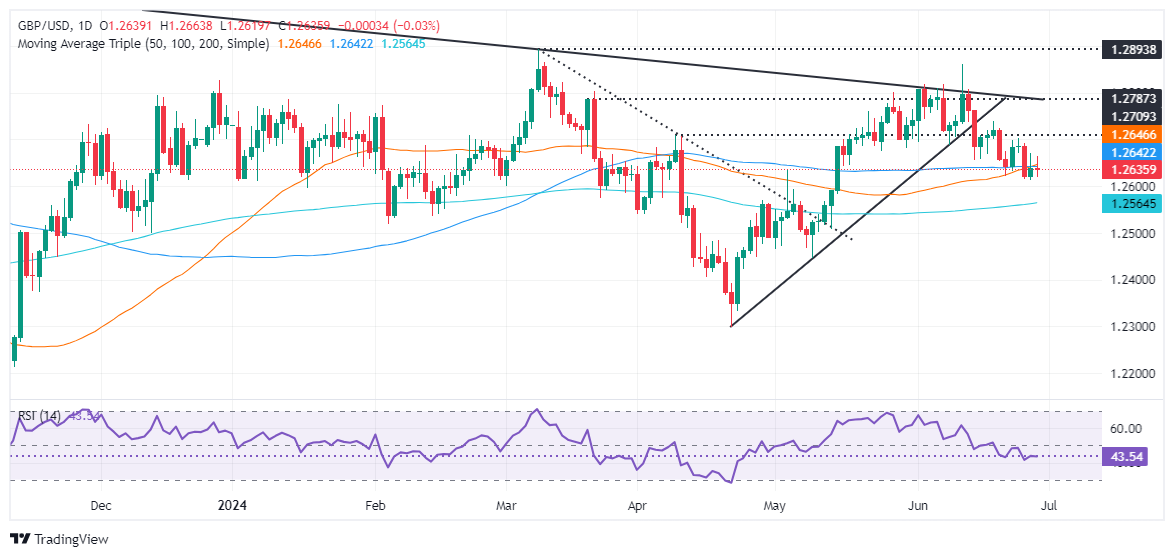- GBP/USD is stable after a positive UK GDP report and the rise of the US PCE Index.
- Technicians are limiting the pair below 1.2700, key for buying momentum.
- Strong support at 1.2634/45 (50 and 100 DMAs); The RSI suggests dominance of sellers, risk of further losses.
He GPB/USD The pair is subdued during the North American session on Friday following a positive UK GDP report, but a rise in the Fed’s preferred inflation gauge, the PCE Price Index, kept the pair trading at 1.2642, virtually unchanged.
GBP/USD Price Analysis: Technical Perspective
After bouncing off the weekly lows hit on Wednesday, GBP/USD limited its losses and stayed below the psychological figure of 1.2700, a crucial level for buyers to regain control.
However, sellers are also under pressure as they face strong support at the confluence of the 50- and 100-day moving averages (DMAs) around 1.2634/45, which, if cleared, could further exacerbate the downside.
The RSI suggests that sellers remain in control, meaning more losses are expected.
The psychological level of 1.2600 would be the first support. Once overcome, the next demand zone to challenge would be the 200-day moving average at 1.2555, followed by 1.2500.
For a bullish continuation, traders must reclaim 1.2700 and clear a previous support-turned-resistance trend line around 1.2730/40.
GBP/USD Price Action – Daily Chart
The British Pound
The Pound Sterling (GBP) is the oldest currency in the world (886 AD) and the official currency of the United Kingdom. It is the fourth most traded currency unit in the world, accounting for 12% of all transactions and an average of $630 billion a day, as of 2022.
Its key currency pairs are GBP/USD, also known as the “Cable,” which accounts for 11% of the forex market, GBP/JPY, or the “Dragon” as it is known to traders (3%), and EUR/GBP (2%). The British Pound is issued by the Bank of England (BoE).
The most important factor influencing the value of the Pound Sterling is the monetary policy decided by the Bank of England. The Bank of England bases its decisions on achieving its main objective of “price stability”, that is, a stable inflation rate of around 2%. Its main tool to achieve this is the adjustment of interest rates.
When inflation is too high, the Bank of England tries to contain it by raising interest rates, which makes access to credit more expensive for individuals and companies. This tends to be positive for the GBP, as higher interest rates make the UK a more attractive place for global investors to park their money.
When inflation is too low, it is a sign that economic growth is slowing. In this scenario, the BoE will consider lowering interest rates to make credit cheaper, so that companies borrow more to invest in growth-generating projects.
The data released gauges the health of the economy and can influence the value of the Pound. Indicators such as GDP, manufacturing and services PMIs, and employment can influence the direction of the Pound.
A strong economy is good for the British pound. Not only does it attract more foreign investment, but it may encourage the Bank of England to raise interest rates, which will directly strengthen the Pound. Otherwise, if economic data is weak, the pound is likely to fall.
Another significant data for the pound sterling is the trade balance. This indicator measures the difference between what a country earns from its exports and what it spends on imports during a given period.
If a country produces highly sought-after exports, its currency will benefit exclusively from the additional demand created by foreign buyers who wish to purchase these goods. Therefore, a positive net trade balance strengthens a currency and vice versa for a negative balance.
Source: Fx Street
I am Joshua Winder, a senior-level journalist and editor at World Stock Market. I specialize in covering news related to the stock market and economic trends. With more than 8 years of experience in this field, I have become an expert in financial reporting.








